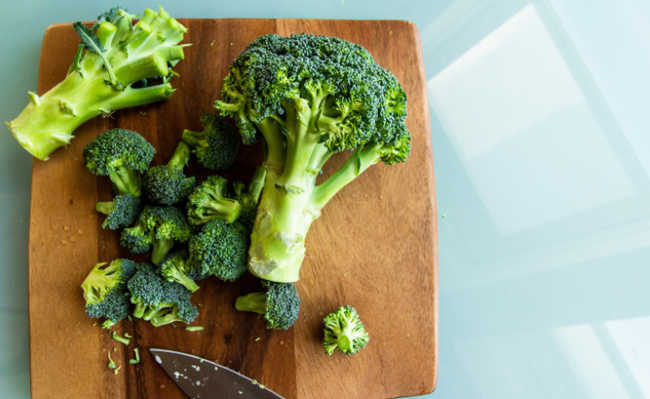The best food for fibromyalgia
Avoiding gluten, being a vegetarian and ingesting broccoli, tofu, beans and dark green leaves are feeding practices for fibromyalgia

Edited and resized image by Louis Hansel @shotsoflouis, is available at no Unsplash
Knowing the best diet for fibromyalgia can be a way to deal with the symptoms of this condition. Fibromyalgia is a chronic and rheumatologic disease that causes widespread pain throughout the body, being able to make the person unwilling to do any activity, even the simple act of sleeping, as the pain becomes unbearable. It can be difficult to diagnose because many of your symptoms are similar to other conditions. It can also be difficult to treat. Food can help, but it is important to seek medical advice that specializes in treating fibromyalgia.
Food for Fibromyalgia
Have a balanced diet
Maintaining a balanced diet is a good idea for anyone, regardless of fibromyalgia. This diet should include fresh fruits and vegetables, whole grains, healthy fats like avocados and olive oil. Avoid unhealthy foods, including anything processed or fried, and excessive amounts of saturated fat. Also, limit the amount of salt and sugar in your diet.
- What is saturated fat? Its make bad?
Prefer foods that give energy
Fibromyalgia can make you feel tired and worn out. But some foods can improve mood. Avoid sweets as they will give you a quick spike in sugar, followed by a sharp drop. Instead, combine proteins or fats with carbohydrates to decrease their absorption. Choose fresh, wholesome foods, rich in fiber and low in sugar, such as:
- Almonds and other nuts and seeds
- Broccoli
- Beans (beans, lentils, chickpeas, peas)
- tofu
- Oat
- dark green leaves
- Avocado
- Saffron
- Quinoa
- Olive oil
- Cinnamon
Be vegetarian and avoid dairy products
Some studies have looked at how certain diets affect fibromyalgia. There is evidence that following a vegetarian or vegan diet, rich in plant antioxidants, may offer some relief from symptoms. A study in Alternative and Complementary Medicine found that people who followed a mostly raw vegetarian diet had less pain.
Limiting dairy consumption can help alleviate fibromyalgia symptoms. This is because many dairy products contain saturated fat. People should try to opt for low-fat versions or dairy alternatives such as soy milk.
- Nine Calcium-Rich Foods That Are Not Dairy
Avoid foods that trigger fibromygia
Although there is no single “fibromyalgia diet”, studies reveal that certain ingredients or types of foods can be problematic for fibromyalgia conditions. These include:
- FODMAPs
- Foods containing gluten
- Food additives or food chemicals
- Excitotoxins
Some people confirm that they feel better when they eat - or avoid - certain types of food. You may need to keep a food diary to find out which foods seem to trigger or improve your symptoms. Read on to learn about foods that can negatively affect your symptoms.
Consume anti-inflammatory foods
There is evidence to suggest that adopting an anti-inflammatory diet can help people with chronic pain. An anti-inflammatory diet is not a specific eating plan, but its guidelines can help people make appropriate choices. See a list of 16 anti-inflammatory foods.
FODMAPs
Fermentable oligosaccharides, disaccharides, monosaccharides and polyols (FODMAPs) are certain carbohydrates fermented by intestinal bacteria in the digestive tract and can promote fibromyalgia symptoms in some people. One study found that people with fibromyalgia had better symptoms and quality of life and lost weight when following a diet low in FODMAP.
Gluten Sensitivity
One study has shown that non-celiac gluten sensitivity may be an underlying cause of fibromyalgia. Fibromyalgia patients tested negative for celiac disease yet had significant improvements in indicators of pain and/or quality of life when following a gluten-free diet.
Excitotoxins and other food additives
According to the Arthritis Foundation, food additives called excitotoxins can worsen some of the symptoms of fibromyalgia. Examples of these include monosodium glutamate, which is a flavor enhancer, and aspartame, which is an artificial sweetener.
Research conducted in 2012 found that people with fibromyalgia and irritable bowel syndrome (IBS) who stopped using mosodium glutamate and aspartame had a 30% reduction in symptoms. However, symptoms returned when they started consuming these additives again.
In 2016, the magazine Pain Management reported that one-month elimination of aspartame, monosodium glutamate (MSG) and altered proteins - such as those found in protein isolates and hydrolyzed proteins - resulted in improvements in the pain of fibromyalgia. When patients added these substances back to their diets, their symptoms returned or worsened.
keep weight healthy
Another benefit of eating a healthy diet is that it can help keep your weight under control. A journal study Clinical Rheumatologydes showed that people with fibromyalgia who are also obese enjoyed a better quality of life when they lost weight. They had less pain and depression, fewer tender spots and slept better after losing a few pounds. This study suggests that weight loss may be an important part of fibromyalgia treatment.
Magnesium for Fibromyalgia
It is possible that there is a connection between magnesium deficiency and fibromyalgia. Try consuming foods rich in magnesium to improve your magnesium levels.










